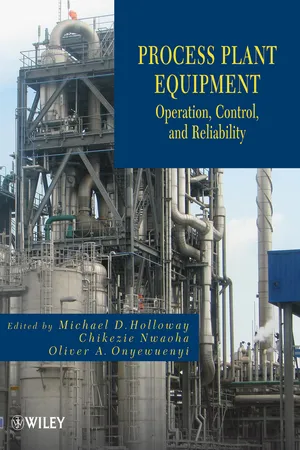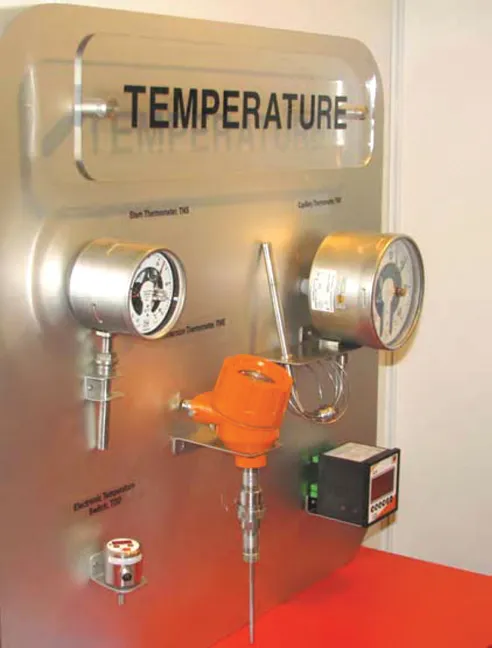
Process Plant Equipment
Operation, Control, and Reliability
- English
- ePUB (mobile friendly)
- Available on iOS & Android
Process Plant Equipment
Operation, Control, and Reliability
About This Book
"Process Plant Equipment Book is another great publication from Wiley as a reference book for final year students as well as those who will work or are working in chemical production plants and refinery…" -Associate Prof. Dr. Ramli Mat, Deputy Dean (Academic), Faculty of Chemical Engineering, Universiti Teknologi Malaysia
"…give[s] readers access to both fundamental information on process plant equipment and to practical ideas, best practices and experiences of highly successful engineers from around the world… The book is illustrated throughout with numerous black & white photos and diagrams and also contains case studies demonstrating how actual process plants have implemented the tools and techniques discussed in the book. An extensive list of references enables readers to explore each individual topic in greater depth…" – Stainless Steel World and Valve World, November 2012
Discover how to optimize process plant equipment, from selection to operation to troubleshooting
From energy to pharmaceuticals to food, the world depends on processing plants to manufacture the products that enable people to survive and flourish. With this book as their guide, readers have the information and practical guidelines needed to select, operate, maintain, control, and troubleshoot process plant equipment so that it is efficient, cost-effective, and reliable throughout its lifetime. Following the authors' careful explanations and instructions, readers will find that they are better able to reduce downtime and unscheduled shutdowns, streamline operations, and maximize the service life of processing equipment.
Process Plant Equipment: Operation, Control, and Reliability is divided into three sections:
- Section One: Process Equipment Operations covers such key equipment as valves, pumps, cooling towers, conveyors, and storage tanks
- Section Two: Process Plant Reliability sets forth a variety of tested and proven tools and methods to assess and ensure the reliability and mechanical integrity of process equipment, including failure analysis, Fitness-for-Service assessment, engineering economics for chemical processes, and process component function and performance criteria
- Section Three: Process Measurement, Control, and Modeling examines flow meters, process control, and process modeling and simulation
Throughout the book, numerous photos and diagrams illustrate the operation and control of key process equipment. There are also case studies demonstrating how actual process plants have implemented the tools and techniques discussed in the book. At the end of each chapter, an extensive list of references enables readers to explore each individual topic in greater depth.
In summary, this text offers students, process engineers, and plant managers the expertise and technical support needed to streamline and optimize the operation of process plant equipment, from its initial selection to operations to troubleshooting.
Frequently asked questions
Information
I.1 Types of Instruments
| Sensor | Advantages | Limitations |
| Thermocouple | Self-powered | Nonlinear |
| Simple | Low voltage | |
| Rugged | Reference required | |
| Inexpensive | Least stable | |
| Wide variety | Least sensitive | |
| Wide range | ||
| RTD | Most stable and accurate | Expensive |
| Area sensing | Current source required | |
| More linear than thermocouple | Slow response time | |
| Most repeatable | Low sensitivity to small temperature change | |
| Contamination resistant | Self-heating | |
| Infrared | No contact required | High initial cost |
| Very fast response time | More complex support electronics | |
| Good stability over time | Spot size restricts application | |
| High repeatability | Emissivity variations affect readings | |
| No oxidation/corrosion to affect sensor | Accuracy affected by dust, smoke, and background radiation | |
| Bimetallic | Simple, robust, and inexpensive | Not recommended for measurement of temperature above 550°C |
| Has good accuracy | ||
| The metals undergo permanent warp distortion | ||
| Can measure temperature in the range −40 to 550°C | ||
| Use limited to local mounting | ||
| Can withstand 50% overage temperature measurement | ||
| Liquid-filled glass | More economical, versatile, widely used | Compensation necessary for ambient (surrounding) temperature changes and long capillary tube |
| Rugged in construction, low maintenance | ||
| For accuracy the pressure bulb should be large | ||
| Can be used for remote indication | ||
| In case of error the entire system has to be replaced | ||
| Stable in operation | ||
| System provides enough power to drive the control mechanism |
I.1.1 Liquid-Filled Glass Thermometers

I.1.2 Bimetallic Thermometers
I.1.3 Thermocouples
Table of contents
- Cover
- Copyright
- Dedication
- Title Page
- Contributors
- Preface
- Section I: Process Equipment Operation
- Section II: Process Plant Reliability
- Section III: Process Measurement, Control, and Modeling
- Appendix I: Methods for Measuring Process Temperature
- Appendix II: Airflow Troubleshooting
- Appendix III: MIG Shielding Gas Control and Optimization
- Appendix IV: Rupture Disk Selection
- Appendix V: Pressure Gauge Selection
- Appendix VI: Corrosion and Its Mitigation in the Oil and Gas Industries
- Appendix VII: Mixers
- Appendix VII: Glossary of Processing Terms
- Index